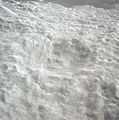Patsaev (crater)
|
Patsaev (upper left of center) with Patsaev Q (below left of Patsaev) and Patsaev K (lower right), on the far side of the moon. The rim of Tsiolkovskiy is in lower left corner. (Apollo 15 Mapping Camera image) | |
| Coordinates | 16°42′S 133°24′E / 16.7°S 133.4°ECoordinates: 16°42′S 133°24′E / 16.7°S 133.4°E |
|---|---|
| Diameter | 55 km[1] |
| Depth | Unknown |
| Colongitude | 227° at sunrise |
| Eponym | Viktor I. Patsayev |
Patsaev is a lunar crater that lies on the far side of the Moon, to the northeast of the prominent crater Tsiolkovskiy. To the northwest is the smaller crater Lander.
This is a heavily damaged crater that now appears as little more than an irregular depression in the surface. Both the outer rim and interior floor are streaked by jumbled ridges of material that are radial to Tsiolkovskiy. Most likely this is ejecta deposited during Tsiolkovskiy's formation.
It is named after cosmonaut Viktor Patsayev who died in Soyuz 11 mission.
Kira
Within Patsaev Q is a tiny crater that was officially designated Kira by the IAU.[2] Kira is a Russian feminine name – the crater is not actually named for any specific person. The selenographic coordinates of this feature are 17.6° S, 132.8° E, and the diameter is 3 km.
Satellite craters
By convention these features are identified on lunar maps by placing the letter on the side of the crater midpoint that is closest to Patsaev.
| Alder | Latitude | Longitude | Diameter |
|---|---|---|---|
| Patsaev K | 18.8° S | 134.5° E | 53 km |
| Patsaev Q | 17.8° S | 132.7° E | 34 km |
The satellite crater Patsaev Q is located just to the southwest of Patsaev.[3] In the past it was suggested that this feature be renamed Chenier, in honor of André Marie Chénier the French poet, but this was never adopted by the IAU.
-

Oblique view facing southwest of Patsaev Q (and Kira) from Apollo 17
References
- ↑ Feature 4611, Gazetteer of Planetary Nomenclature, International Astronomical Union (IAU) Working Group for Planetary System Nomenclature (WGPSN)
- ↑ Feature 3045 Kira, Gazetteer of Planetary Nomenclature, International Astronomical Union (IAU) Working Group for Planetary System Nomenclature (WGPSN)
- ↑ Feature 11874, Gazetteer of Planetary Nomenclature, International Astronomical Union (IAU) Working Group for Planetary System Nomenclature (WGPSN)
- Andersson, L. E.; Whitaker, E. A. (1982). NASA Catalogue of Lunar Nomenclature. NASA RP-1097.
- Blue, Jennifer (July 25, 2007). "Gazetteer of Planetary Nomenclature". USGS. Retrieved 2007-08-05.
- Bussey, B.; Spudis, P. (2004). The Clementine Atlas of the Moon. New York: Cambridge University Press. ISBN 978-0-521-81528-4.
- Cocks, Elijah E.; Cocks, Josiah C. (1995). Who's Who on the Moon: A Biographical Dictionary of Lunar Nomenclature. Tudor Publishers. ISBN 978-0-936389-27-1.
- McDowell, Jonathan (July 15, 2007). "Lunar Nomenclature". Jonathan's Space Report. Retrieved 2007-10-24.
- Menzel, D. H.; Minnaert, M.; Levin, B.; Dollfus, A.; Bell, B. (1971). "Report on Lunar Nomenclature by the Working Group of Commission 17 of the IAU". Space Science Reviews 12 (2): 136–186. Bibcode:1971SSRv...12..136M. doi:10.1007/BF00171763.
- Moore, Patrick (2001). On the Moon. Sterling Publishing Co. ISBN 978-0-304-35469-6.
- Price, Fred W. (1988). The Moon Observer's Handbook. Cambridge University Press. ISBN 978-0-521-33500-3.
- Rükl, Antonín (1990). Atlas of the Moon. Kalmbach Books. ISBN 978-0-913135-17-4.
- Webb, Rev. T. W. (1962). Celestial Objects for Common Telescopes (6th revision ed.). Dover. ISBN 978-0-486-20917-3.
- Whitaker, Ewen A. (1999). Mapping and Naming the Moon. Cambridge University Press. ISBN 978-0-521-62248-6.
- Wlasuk, Peter T. (2000). Observing the Moon. Springer. ISBN 978-1-85233-193-1.
External links
- LTO-102A1 Patsaev — L&PI topographic map.
